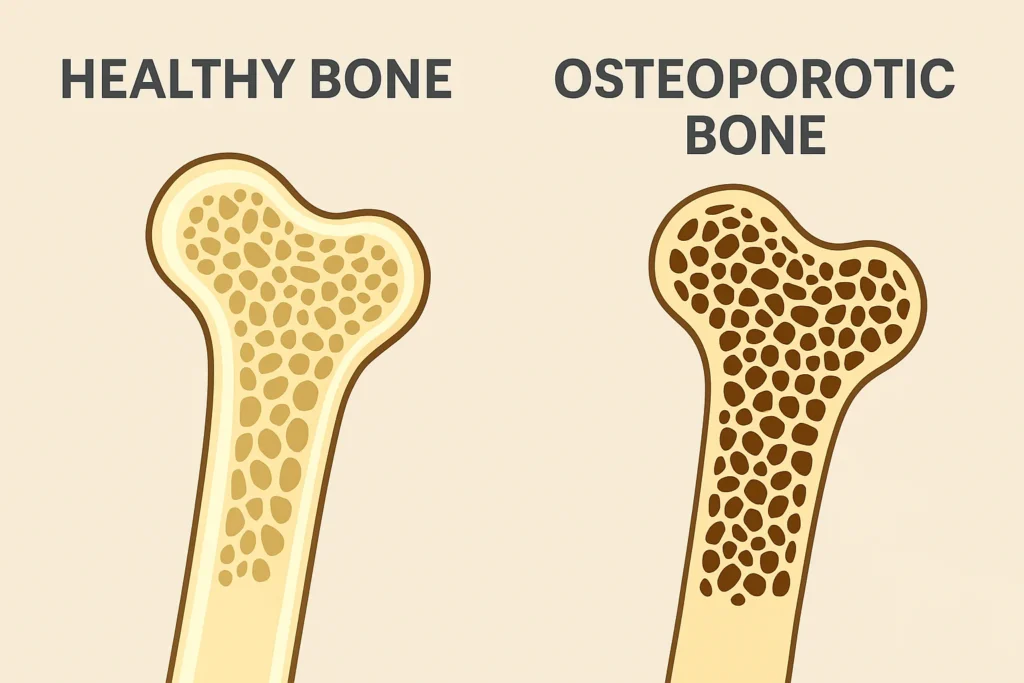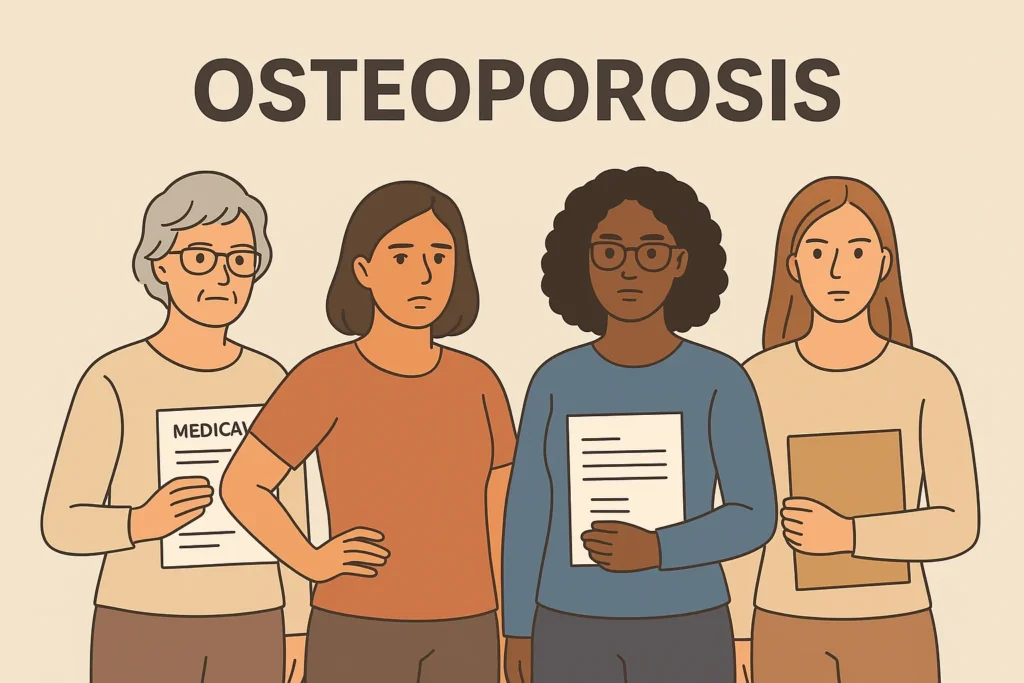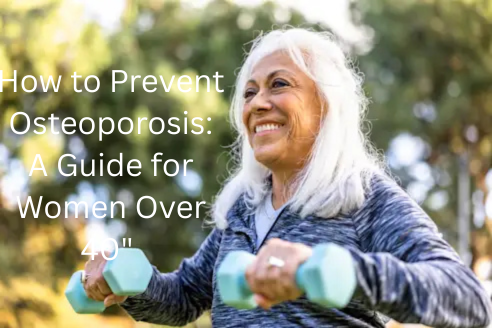Discover the early signs of osteoporosis in women, including subtle symptoms, risk factors, and preventive strategies for better bone health.
What Is Osteoporosis?
Osteoporosis causes bones to become weak and brittle due to decreased bone density, increasing fracture risk. It mainly affects women over 50 but can start developing earlier.
Osteoporosis, often called the “silent disease,” affects millions of women worldwide. It weakens bones, making them fragile and more prone to fractures. Many women do not realize they have osteoporosis until a bone breaks, highlighting the importance of recognizing its early signs. Women are particularly at risk due to hormonal changes during menopause, smaller bone structures, and family history. Understanding the subtle warning signals of osteoporosis can help with timely intervention, lifestyle changes, and treatments to protect long-term bone health.
This article explores the early signs of osteoporosis in women, why it develops, how to identify risk factors, and what steps can be taken to prevent or manage the condition.
Early Signs of Osteoporosis in Women
Osteoporosis does not usually present clear symptoms in its earliest stages. However, there are warning signs women can look out for:
1. Frequent Fractures
One of the most common indicators of osteoporosis is breaking bones easily, often from minor falls or accidents. Fractures of the wrist, spine, or hip are especially telling.
2. Loss of Height
Women with osteoporosis may notice they are gradually getting shorter. This happens when the bones in the spine (vertebrae) collapse or compress, causing reduced height.
3. Stooped Posture
A noticeable curvature of the upper back, known as kyphosis or “dowager’s hump,” may develop due to weakened vertebrae. This posture change is often an early sign of bone weakening.
4. Back Pain
Chronic or sudden back pain can occur when osteoporosis leads to fractures in the vertebrae. This pain can be sharp and severe, or dull and persistent.
5. Weak Grip Strength
Decreasing hand strength is sometimes overlooked but can be an indicator of reduced bone density and muscle weakness, both linked to osteoporosis risk.
6. Brittle Nails
Though not a direct sign, nails that break easily may signal poor bone health and nutritional deficiencies, especially low calcium or vitamin D.
Causes and Risk Factors
Several factors contribute to the development of osteoporosis in women:
-
Hormonal Changes: Estrogen levels drop significantly after menopause, accelerating bone loss.
-
Genetics: A family history of osteoporosis increases the likelihood of developing the condition.
-
Nutritional Deficiencies: Inadequate calcium, vitamin D, and protein intake weakens bones.
-
Sedentary Lifestyle: Lack of weight-bearing exercise contributes to reduced bone density.
-
Medical Conditions and Medications: Thyroid disorders, rheumatoid arthritis, or long-term steroid use can increase risk.
-
Age: The risk grows with age, especially after 50.
Diagnosis and Medical Evaluation
Since osteoporosis progresses silently, screening is critical:
-
Bone Density Test (DEXA scan): Measures bone mineral density to assess fracture risk.
-
Blood Tests: Evaluate calcium, vitamin D, thyroid, and parathyroid hormone levels.
-
X-rays: May reveal fractures or spinal compression but often miss early osteoporosis.
Women over 65, and younger women with risk factors, are strongly advised to undergo bone density screenings.
Lifestyle and Dietary Solutions
Adopting healthy habits can help prevent or manage osteoporosis:
1. Nutrition
-
Calcium-rich foods: Dairy products, leafy greens, almonds, and fortified plant-based milk.
-
Vitamin D: Sunlight exposure, fatty fish, and supplements if needed.
-
Protein: Essential for bone structure and repair.
-
Limit alcohol and caffeine: Excessive consumption can interfere with calcium absorption.
2. Exercise
-
Weight-bearing exercises: Walking, jogging, and dancing help build bone strength.
-
Resistance training: Strengthens muscles and bones, reducing fracture risk.
-
Balance exercises: Yoga and tai chi help prevent falls by improving stability.
3. Lifestyle Adjustments
-
Quit smoking, as it reduces bone mass.
-
Maintain a healthy body weight.
-
Get regular check-ups to monitor bone health.
Prevention and Long-Term Strategies
Preventing osteoporosis is easier than reversing it. Women should prioritize bone health early in life. Practical strategies include:
-
Begin weight-bearing exercise routines before menopause.
-
Ensure adequate calcium and vitamin D intake during adolescence and early adulthood.
-
Monitor bone density regularly, especially after 50.
-
Manage underlying conditions such as thyroid or autoimmune disorders.
For women already diagnosed, medications such as bisphosphonates, hormone replacement therapy, or bone-building drugs may be recommended by doctors to slow bone loss and strengthen bone density.
How to Prevent Osteoporosis for Women Over 40.
FAQs About Osteoporosis in Women
1. Can osteoporosis be reversed?
No, but treatments and lifestyle changes can slow progression and strengthen bones.
2. Who is most at risk?
Postmenopausal women, those with family history, and women with low body weight face the highest risk.
3. What’s the difference between osteopenia and osteoporosis?
Osteopenia is reduced bone density that isn’t as severe as osteoporosis but increases the risk of developing it.
4. How much calcium should women consume daily?
Most adult women need 1,000 mg daily, increasing to 1,200 mg after age 50.
5. When should women get tested for osteoporosis?
Screening is recommended at age 65, or earlier if risk factors are present.
Conclusion
Osteoporosis often develops silently, but early signs like frequent fractures, loss of height, stooped posture, and persistent back pain should never be ignored. Women are particularly vulnerable due to hormonal shifts, lifestyle factors, and age-related bone changes. By recognizing early warning signs, adopting a bone-healthy lifestyle, and seeking timely medical screening, women can significantly lower their risk of severe fractures and maintain strong bones throughout life.



